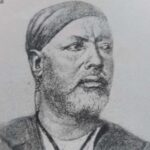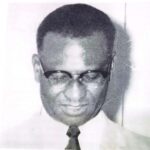PREMPEH I, AGYEMANG
- 5 Min Read
Nana Agyemang Prempeh I (circa 1872-1931) was the Asantehene (ruler of the Asante) from 1888-1931. His reign was perhaps the most dramatic, the most eventful and the most tragic of any of the reigns in Asante history.

PHOTO CAPTION: Prempeh I SOURCE: EA Library
He was probably born in or about 1872. His mother was Yaa Akyaa, the queen mother or Asantehemaa, and his father was Kwesi Gyambibi a son of Kwaku Dua I, Asantehene from 1834-1867. He succeeded his brother at a tender age, probably 16 or 17. His accession was preceded by succession disputes. His claim to the golden stool was contested by Yaw Atwereboana, a member of the Asante royal family.
Prempeh was supported by the Asantehemaa, the Amanhene (paramount chiefs) of Dwaben to the northeast, Bekwai to the south, Offinso to the north, and Edweso to the east, as well as by some of the Kumase chiefs, whilst Atwereboana drew his support from the Amanhene of Mampon and Nsuta to the north and Kokofu to the south. Prempeh’s party won the civil war which followed, and he was enstooled as Asantehene in the presence of a British officer, Captain E. A. Barnett, in 1888.
Prempeh was installed as Asantehene on March 26, 1888. Only six years later, on June 11,1894, was he formally to accede to the golden stool of Asante. Although only 16 years old in 1888 by a shrewd mixture of force and diplomacy he was able to suppress a Kokofu rebellion, with the support of Mampon and Nsuta. He also began negotiations for the return of refugees from Kokofu and from Adanse (also to the south) who had fled to the coast.
He also started secret negotiations with Kwawu to the east and Akyem to the southeast with a view to forming an alliance with Samory Touré (circa 1830-1900), the Mandingo warrior who had conquered Gyaman, northwest of Asante, which extended into what is now Ivory Coast, and had also conquered a part of what is now northern Ghana.
Furthermore, to revive the northern part of the Asante empire, and to strengthen the Asante economically, he attacked and conquered Nkoranza to the north (1892-1893), renewed the alliance with Salaga, far to the northeast, and threatened to invade Atebubu, also to the northeast in 1893.
The success of Prempeh alarmed the British who, after the Sagrenti war of 1873-1874 between the British and the Asante, had initiated a policy aimed at weakening and then eventually destroying Asante. They reacted by sending a force into Akyem, Kwawu (east of Kumase), and Atebubu in 1893, and between 1891-1893 they continually pressed the Asantehene to accept a British resident in Kumase.
Prempeh firmly but politely turned down the British offer, saying that “Asante must remain independent as of old, at the same time being friendly with all white men.” In addition, he dispatched a delegation to Britain to put his case directly to the British government.
But the fear of an Asante-Mandingo alliance and of the revival of Asante power appears to have frightened the British, for they decided that Prempeh, the centre of Asante resistance, must be deposed and deported. They found an excuse in the failure of Asante to pay the heavy indemnity imposed on it after its defeat in 1874. An army was sent to Kumase under the command of Sir Francis Scott, with major Robert Baden Powell (later to found the Boy Scout movement) in charge of the local troops. At a public meeting the Asantehene readily offered his submission.
He also undertook to pay 700 of the 50,000 ounces of gold of the indemnity and promised to pay the rest by instalment and to accept British protection. The British however, had already made up their minds to annex Asante. They therefore deposed and arrested Prempeh, his mother, his father, his brother, two other close relatives, the paramount chiefs of Mampon, Offinso and Edweso, the Kurontihene (war leader) of Kumase, the Akwamuhene of Kumase, and a number of the Kumase military captains.
The Asante wanted to fight to prevent the British from having their own way, but Prempeh himself cautioned moderation and advised them against a course of action which might eventually destroy the Asante nation. The Asantehene and his entourage were first sent to Elmina, then to Sierra Leone, and finally to the Seychelles Islands. In 1901, after the Yaa Asantewaa war of 1900-1901, the British sent another group of exiles, consisting of Yaa Asantewaa the queen mother of Edweso, 15 chiefs, and others to join Prempeh and the first party in Seychelles. The British then annexed Asante itself, declaring it a Crown Colony in 1902.
After several representations were made to the British government by J. E. Casely Hayford and Nana Ofori Atta I, ruler of Akyem Abuakwa, Prempeh was allowed to return to Kumase in 1924 as a private citizen. Most of his entourage had died during their years in exile. But since the people of Asante regarded him as their king, he was recognised as the Kumasehene in 1926. Besides, the British found that they could not apply the policy of “indirect rule” effectively if there was no head of the Kumase division.
Prempeh died in 1931, and his nephew Kwame Kyeretwie who became Prempeh II, was enstooled in his place. In 1935, the Asante union was restored by the British government (which was called the Asante Confederacy), and Prempeh II became the Asantehene. It is worth recording, however, that in Asante eyes Prempeh I was never destooled by his people, but remained the Asantehene till his death, so that the restoration of the Union remained meaningless to them, as in their eyes it had never ceased to exist.
J. K. FYNN





